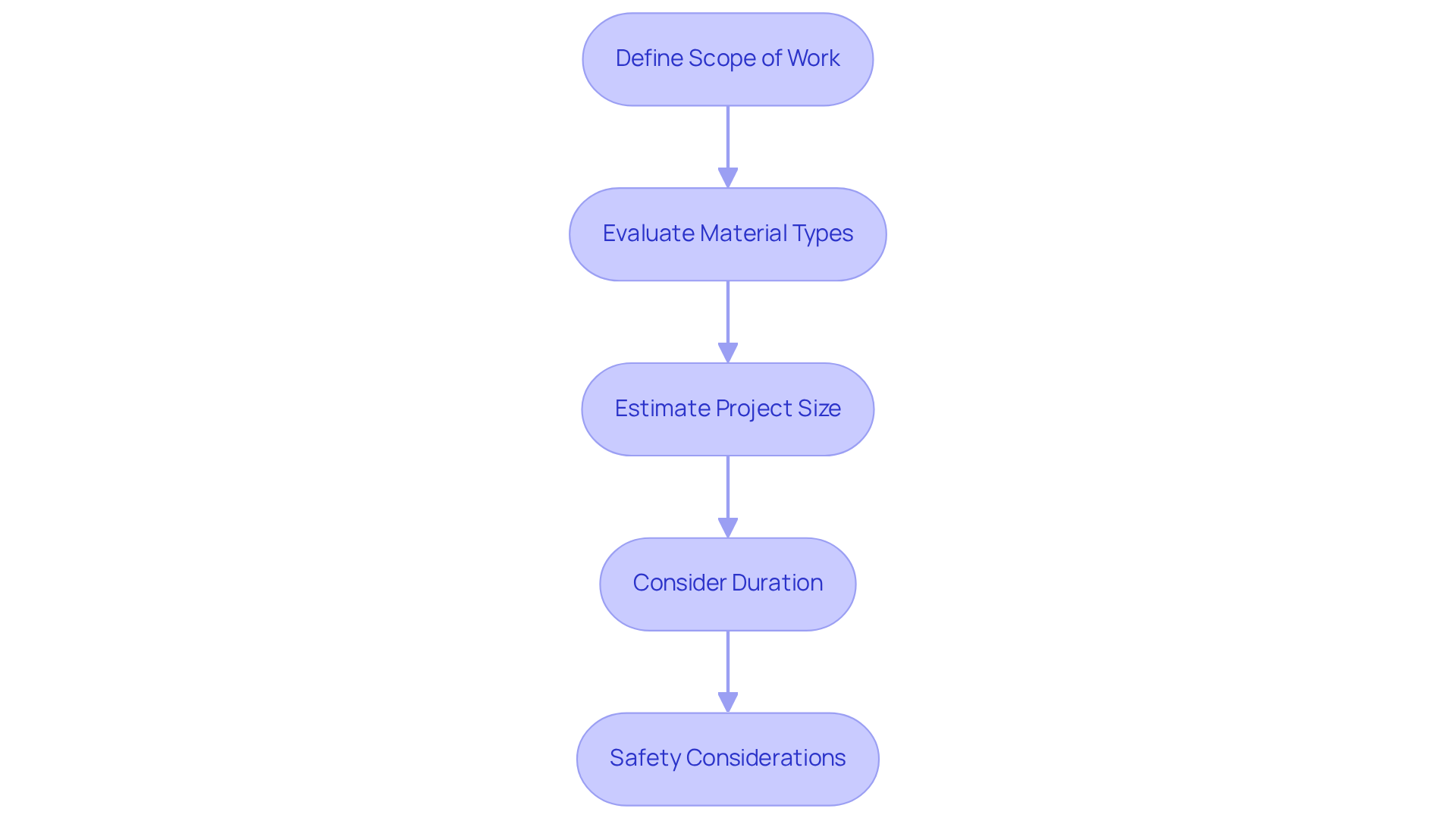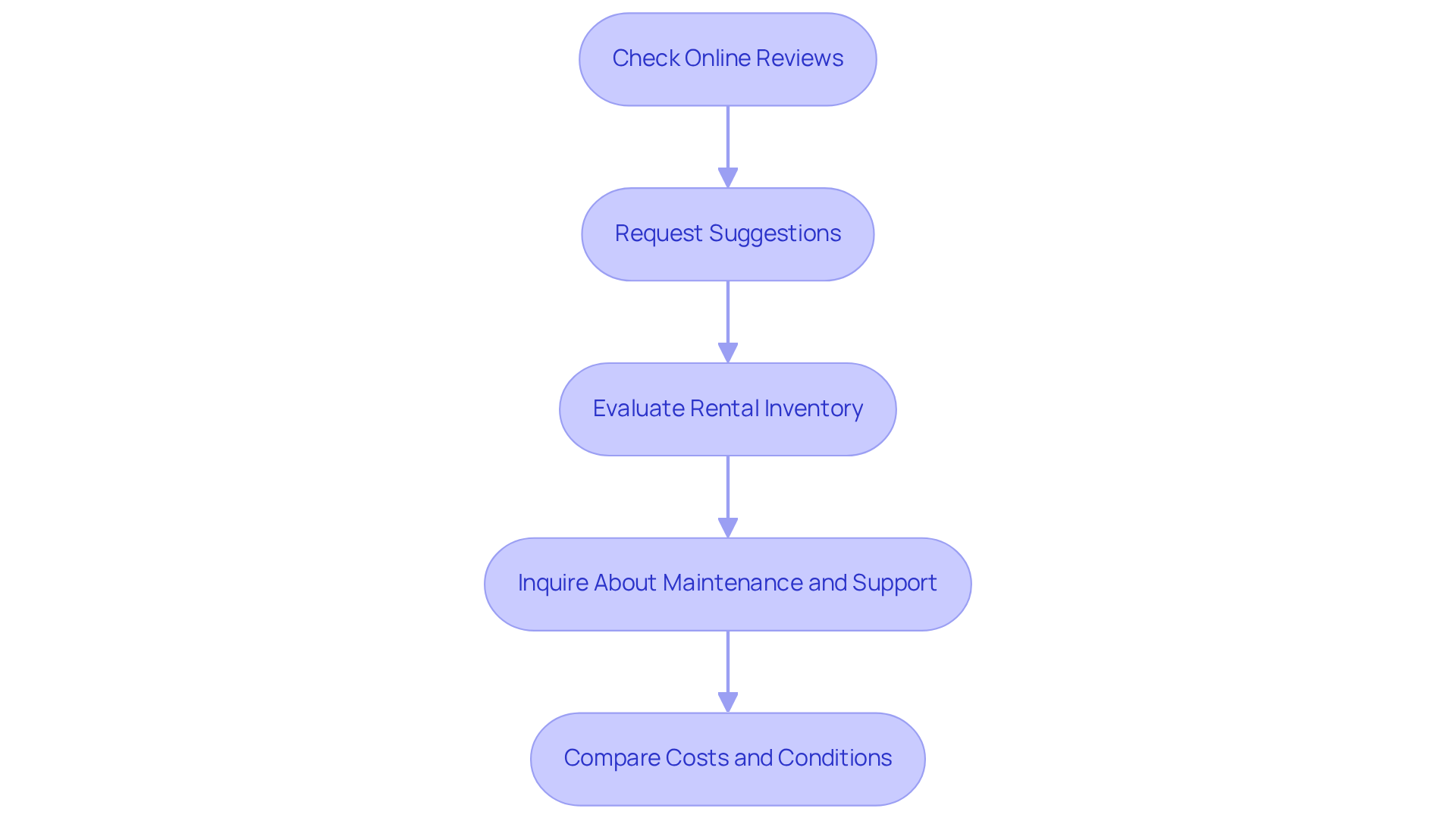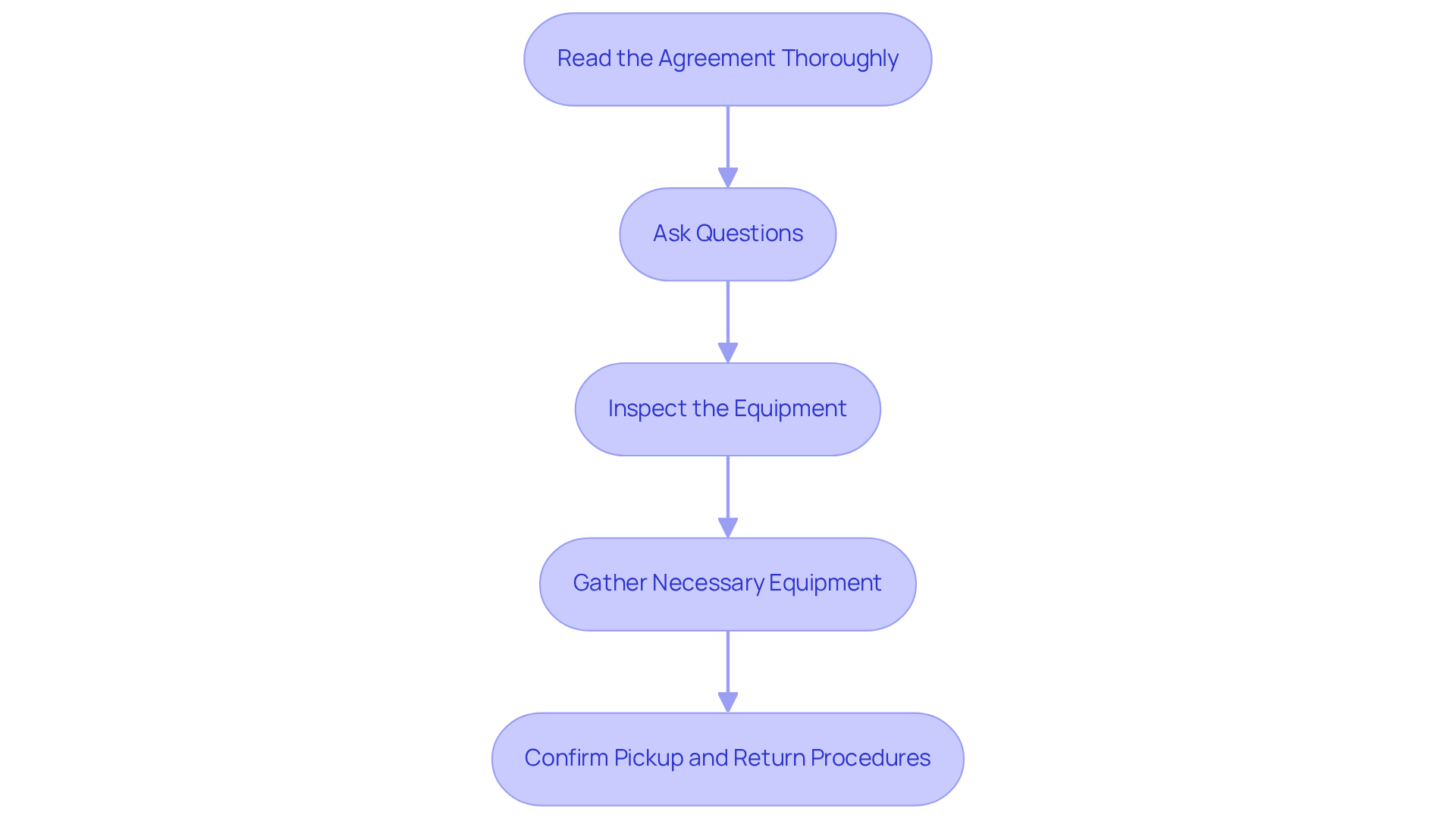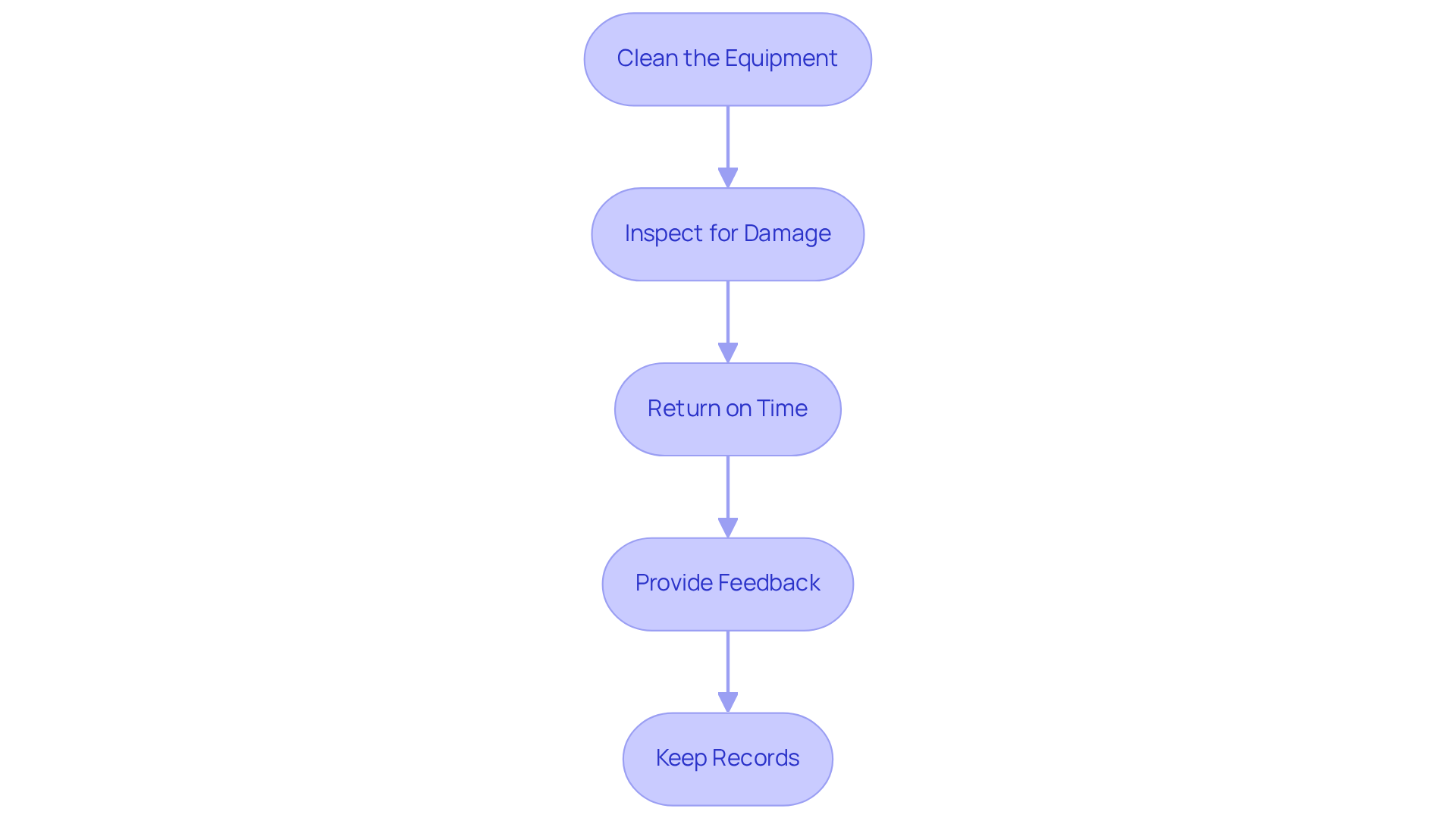Overview
The four key steps for a successful gas-powered jackhammer rental are crucial for ensuring project success.
- Assess your project needs to determine the specific requirements for the job at hand.
- Research rental services to find a reputable provider that offers reliable equipment.
- Understanding the rental agreement is essential, as it outlines the terms and conditions of your rental experience.
- Ensure proper equipment return to avoid any additional fees or complications.
Thorough preparation, including defining project requirements and selecting a reputable rental provider, is essential for a smooth rental experience and successful project completion.
Key Highlights:
- Assess project needs by defining the scope of work, evaluating material types, estimating project size, and considering rental duration.
- Prioritise safety by familiarising yourself with necessary protective gear and operational guidelines before using the jack hammer.
- Research rental services by checking online reviews, seeking recommendations, and evaluating the rental inventory for variety.
- Inquire about maintenance practises to ensure the equipment is well-maintained and reliable for your project.
- Understand the rental agreement by reading it thoroughly, asking questions, and inspecting the equipment for pre-existing damage.
- Prepare for pickup by gathering necessary safety gear and confirming pickup and return procedures.
- Return the equipment clean and on time, inspect for damage, provide feedback on the rental experience, and keep records of the lease agreement.
Introduction
Navigating the world of construction tools can be daunting, particularly when it comes to renting specialized equipment such as gas-powered jackhammers. However, with the right approach, this process can transform into a streamlined component of any project. This guide outlines essential steps to ensure a successful rental experience, starting from:
- Identifying specific project needs
- Selecting a reputable rental service
- Comprehending the intricacies of the rental agreement
Furthermore, what happens when unexpected challenges arise during your rental journey? Understanding these critical factors could mean the difference between a smooth operation and costly setbacks.
Identify Your Project Needs for a Gas Powered Jack Hammer
Before considering a gas powered jack hammer rental, it is crucial to meticulously assess your project requirements. Follow these steps to ensure a successful rental experience:
-
Define the Scope of Work: Clearly outline the specific tasks for which you need the jack hammer, such as breaking concrete slabs, removing pavement, or digging trenches. As John 'Architect' Aarons aptly puts it, 'Building is not just about shelter. It’s about realizing dreams, making statements, creating spaces where life happens.' This mindset will direct your choice of tools and ensure you select the right equipment for your needs.
-
Evaluate Material Types: Identify the materials you will be working with. Different jack hammers are designed for various materials, so knowing whether you are dealing with concrete, asphalt, or brick is essential. This consideration ensures optimal performance and efficiency, allowing you to achieve the best results in your project.
-
Estimate Project Size: Assess the size of the area you will be working on. Bigger undertakings may need more powerful equipment or multiple rentals. Comprehending the scope of your endeavor is essential for efficient planning and resource distribution. For instance, average assignments that typically require a gas powered jack hammer rental can vary, but understanding this can aid in making informed decisions that align with your project goals.
-
Consider Duration: Estimate how long you will need the jack hammer. This will assist you in selecting the appropriate leasing terms and avoiding unnecessary expenses. As Fred 'Foreman' Foster reminds us, 'Success isn’t just the building itself. It’s the journey of building, the growing, the learning.' Planning for the duration is part of that journey, ensuring you are prepared for every phase of your project.
-
Safety considerations include familiarizing yourself with the safety requirements for operating a gas powered jack hammer rental, such as necessary protective gear and operational guidelines. Safety should never be a priority; it should be a precondition in construction, not just a priority. Ensuring safety measures are in place will protect you and your team throughout the project.
By distinctly recognizing your requirements, you can guarantee that you choose the appropriate tools, resulting in a successful leasing experience and task completion.

Research and Select a Reputable Equipment Rental Service
To ensure the success of your project, selecting a trustworthy tool leasing provider is essential. Here are key steps to guide your decision-making process:
-
Check Online Reviews: Investigate customer feedback on platforms such as Google, Yelp, and specialized review websites. Concentrate on evaluations regarding product quality and client support, as these insights can significantly influence your decision. In fact, 84% of construction firms in the U.S. prefer leasing tools rather than buying, underscoring the importance of choosing the right leasing provider.
-
Request Suggestions: Reach out to colleagues or industry experts who have experience with equipment leases. Personal recommendations often lead to reliable offerings that have proven effective in past situations.
-
Evaluate rental inventory to ensure that the rental service provides a diverse selection of gas powered jack hammer rental options, including models that are gas-powered. A varied inventory typically indicates a well-established firm capable of meeting diverse requirements. For instance, EZ Equipment Rental offers a range of gas powered jack hammer rental options that are suited for various concrete projects, guaranteeing you find the right tool for your job.
-
Inquire About Maintenance and Support: Discuss the maintenance practices of the rental provider. Renting from a reputable company like EZ Equipment Rental ensures you receive well-maintained equipment, as their team offers comprehensive support and promptly addresses any issues. Customers have commended EZ Equipment Rental for their quick response times and dependable service, which minimizes downtime. Equipment that is regularly maintained is less likely to fail during your task, ensuring smoother operations. As noted by industry specialists, properly cared-for tools are critical for project success, especially during economic uncertainty.
-
Compare Costs and Conditions: Gather estimates from various leasing providers to assess costs, leasing terms, and any additional charges. Transparency in pricing structures is crucial for avoiding unexpected expenses. Furthermore, consider the average ratings of equipment leasing providers in the Dallas-Fort Worth area to evaluate their reliability.
By conducting thorough research and adhering to these guidelines, you can confidently select a leasing service that aligns with your project needs and provides reliable equipment.

Understand the Rental Agreement and Prepare for Pickup
Before you pick up your gas powered jack hammer rental, it is crucial to understand the leasing agreement for a successful experience. Here’s how to prepare effectively:
- Read the Agreement Thoroughly: Carefully review the terms of the lease, including duration, fees, and penalties for late returns or damage. It’s important to note that nearly 60% of construction projects face delays due to inadequate equipment, making this step essential.
- Ask Questions: Should any part of the agreement be unclear, do not hesitate to seek clarification from the leasing service. Understanding your responsibilities can prevent common pitfalls that lead to disputes.
- Inspect the Equipment: Upon pickup, inspect the jackhammer for any pre-existing damage. Document any issues and ensure they are noted in the rental agreement to avoid disputes later. Thorough documentation is vital, as it aids in reducing possible disagreements regarding the state of the items.
- Gather Necessary Equipment: Ensure you have all required safety gear and tools for operating the jackhammer, such as gloves, goggles, and ear protection. Proper preparation significantly enhances safety and efficiency when utilizing a gas powered jack hammer rental on the job site.
- Confirm Pickup and Return Procedures: Understand the process for both picking up and returning the equipment, including location, hours of operation, and any specific instructions. Familiarity with these procedures enhances your leasing experience and reduces the risk of unexpected issues.
By being well-informed about the leasing agreement and preparing adequately, you can ensure a hassle-free experience, ultimately contributing to the success of your project.

Return the Equipment and Review Your Rental Experience
Returning a gas powered jack hammer rental requires meticulous attention to detail to ensure a seamless process. Follow these essential steps:
-
Clean the Equipment: Begin by thoroughly removing any debris or dirt from the jackhammer before returning it. This not only demonstrates respect for the leasing service but also helps prevent potential cleaning charges. Consistent cleaning methods can significantly lower damage rates, which tend to be particularly elevated during leases. Industry statistics indicate that machinery damage rates during leases can reach up to 30%, making cleaning an indispensable step.
-
Inspect for Damage: Next, carefully examine the tools for any signs of damage incurred during your use. Promptly inform the leasing company of any issues upon return, as neglecting to ensure safe equipment may result in legal responsibilities. Regular inspections are crucial; as noted by MacAllister Machinery, "With regular inspections performed by a trained technician, you will be able to make a repair before it leads to a much more expensive problem."
-
Return on Time: Adhere to the agreed-upon return date and time to avoid incurring late fees. If you anticipate needing an extension, contact the leasing service in advance. Timely returns enhance a positive leasing experience and foster strong relationships with providers.
-
Provide Feedback: After returning the equipment, take a moment to evaluate your leasing experience. Sharing feedback can assist the service in improving their offerings and enhancing customer satisfaction.
-
Keep Records: Finally, retain a copy of the lease agreement and any receipts for your documentation. This documentation is invaluable for future leases or in case of disputes. Keeping these records can clarify misunderstandings and protect your interests.
By adhering to these steps, you not only facilitate a smooth return process for the gas powered jack hammer rental but also contribute positively to the overall rental experience, ensuring that both you and the rental service benefit from the transaction.

Conclusion
Successfully renting a gas-powered jackhammer demands careful planning and informed decision-making. Understanding your project needs, selecting a reputable rental service, comprehending the rental agreement, and ensuring a smooth return process are all essential steps. Each of these components plays a pivotal role in maximizing efficiency and avoiding common pitfalls that can lead to delays or additional costs.
Key insights emphasize the importance of:
- Defining project requirements
- Evaluating equipment options
- Maintaining clear communication with rental providers
Thorough research into customer reviews, coupled with proactive engagement with the rental service, significantly enhances the overall experience. Furthermore, diligence in preparing for pickup and returning the equipment in good condition is vital for fostering positive relationships with rental companies.
In conclusion, the success of renting a gas-powered jackhammer hinges on a combination of preparation, awareness, and responsibility. Implementing these strategies ensures that projects run smoothly and effectively. Embrace these best practices to meet project goals and cultivate a reputation for reliability and professionalism in the construction industry.
Frequently Asked Questions
Why is it important to assess project requirements before renting a gas powered jack hammer?
Assessing project requirements ensures you select the right equipment for your specific tasks, leading to a successful rental experience.
What should I define when outlining the scope of work for a jack hammer?
Clearly outline the specific tasks, such as breaking concrete slabs, removing pavement, or digging trenches, to guide your choice of tools.
How does the type of material affect the choice of jack hammer?
Different jack hammers are designed for various materials, so knowing whether you will be working with concrete, asphalt, or brick is essential for optimal performance and efficiency.
Why is it necessary to estimate the project size when renting a jack hammer?
Understanding the size of the area helps determine if more powerful equipment or multiple rentals are needed, aiding in efficient planning and resource distribution.
What factors should be considered regarding the duration of the jack hammer rental?
Estimating how long you will need the jack hammer helps select appropriate leasing terms and avoid unnecessary expenses.
What safety considerations should be taken into account when using a gas powered jack hammer?
Familiarize yourself with the necessary protective gear and operational guidelines, as safety should be a precondition in construction.
How can recognizing project requirements lead to a successful leasing experience?
By clearly identifying your needs, you can choose the appropriate tools, ensuring effective task completion and a positive rental experience.




